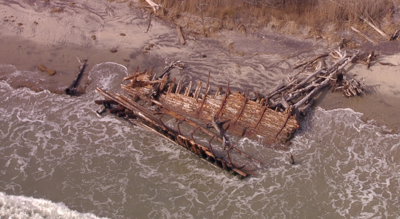PARRAMORE ISLAND, VA - A lasting piece of maritime history was fully revealed this week on the coastal sands of Accomack County.
The shipwreck of the British schooner the Esk has rested on the beach of Parramore Island, just southeast of Wachapreague, since the late 1800s according to the Virginia Coast Reserve Long-Term Ecological Research (VCR LTER) at University of Virginia. Researchers say the 148 ton ship wrecked on September 7th, 1888.
The Esk was on its way from Maracaibo, South America to Providence, Rhode Island carrying 180 tons of dyewood, according to historical records. As it was passing Delmarva, a strong gale reportedly whipped up a rough surf and grounded the schooner 250 yards offshore. Rescuers had to fire a Lyle gun, or a small cannon that fires a line out, multiple times before successfully getting a line secured to the boat to pull the Esk ashore onto Parramore Island just two miles south of the Parramore Life Saving Station.
All seven crewmen from Nova Scotia, including Captain William F Watt, were rescued. Some of the Esks’s cargo of dyewood was also recovered, according to records, but the ship’s total value was listed at $7,500 at the time.
Captain Watt would later write a letter about the incident to the General Superintendent of the United States Life-Saving Service, praising and thanking the Parramore Life Saving Station for their “noble services.”
Today, the remains of the Esk can normally be seen protruding from the sands on Parramore Island, but the schooner was almost fully exposed this week, as seen from Chopper 16.
Dale Clifton at the Shipwreck Museum in Fenwick Island tells WBOC it isn’t uncommon for shipwrecks like these to be uncovered and buried in a constant cycle.
“As the shoreline changes and the formation of the island changes, it’s not uncommon to see a wreck there one day and a week later be completely covered in sand,” Clifton says.
According to Clifton, there are hundreds of shipwrecks along the coast of Delmarva. The Esk, however, seems to be holding up particularly well, even in the face of time, salt water, sand, and wind. The colder Atlantic waters off of Delmarva play a role in that preservation, according to Clifton, as do the lower numbers of toledo worms which bore through wooden hulls. Most importantly, though, is what the Esk was made of - oak.
“The oak was specifically grown for the building of these ships,” Clifton tells WBOC. “Over time, it has survived quite well.”
That sturdy and resilient craftsmanship from nearly 140 years ago may keep the Esk an Accomack County landmark and lasting piece of history for years to come.


